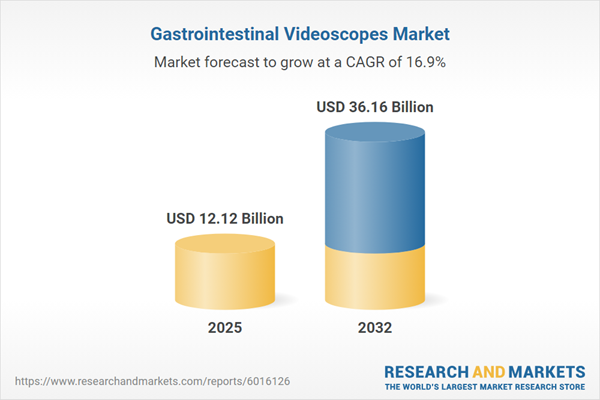Speak directly to the analyst to clarify any post sales queries you may have.
The gastrointestinal videoscopes market is witnessing significant transformation driven by evolving clinical, regulatory, and operational requirements across healthcare systems. Senior decision-makers need precise market intelligence to guide strategic initiatives and ensure sustained competitiveness in this dynamic sector.
Market Snapshot: Gastrointestinal Videoscopes Market Size & Growth Drivers
The gastrointestinal videoscopes market is expected to grow from USD 10.36 billion in 2024 to USD 12.12 billion in 2025 and reach USD 36.16 billion by 2032. This robust growth trajectory reflects a 16.90% CAGR, underpinned by the growing adoption of minimally invasive techniques, heightened awareness around early gastrointestinal disease detection, and ongoing advancements in imaging and digital workflow solutions. The increasing preference for high-definition and mobile systems is improving patient outcomes, while the integration of single-use solutions is supporting infection control and streamlining workflows in both inpatient and outpatient care environments.
Scope & Segmentation of the Gastrointestinal Videoscopes Market
Comprehensive segmentation empowers healthcare procurement and operational leaders to align investments with organizational needs and regional priorities:
- Scope Types: Colonoscopes, duodenoscopes, enteroscopes, and gastroscopes are available as both reusable and single-use devices, offering organizations flexibility with infection control protocols and tailored clinical workflows.
- Device Types: Reusable devices, integrating advanced or conventional reprocessing systems, are complemented by single-use options to suit varying operational capacities and resource availability.
- Applications: Diagnostic functionalities include imaging and biopsy, while therapeutic use cases such as polypectomy, hemostasis, and dilation expand options for comprehensive gastrointestinal intervention and support multidisciplinary care.
- End Users: Designed to meet the demands of ambulatory surgical centers, clinics, public and private hospitals, these products address a range of patient populations and institutional objectives in global healthcare systems.
- Resolution Options: Systems featuring high-definition (1080P, 4K) and standard-definition options enable organizations to select solutions aligned with their clinical accuracy and economic requirements.
- Technologies: The integration of CCD and CMOS image sensors, with front or back illumination, delivers optimized image quality while supporting efficient procurement and cost management across long-term equipment cycles.
- Regions Covered: The market scope includes the Americas (United States, Canada, Mexico, Brazil, Argentina, Chile, Colombia, Peru), Europe, Middle East and Africa (including the United Kingdom, Germany, France and adjacent countries), and Asia-Pacific (China, India, Japan, Australia, Southeast Asia).
- Leading Companies Analyzed: Key market participants include Olympus Corporation, Fujifilm Holdings Corporation, Hoya Corporation, KARL STORZ SE & Co. KG, Ambu A/S, Boston Scientific Corporation, Medtronic plc, Stryker Corporation, Richard Wolf GmbH, Micro-Tech Endoscopy Co., Ltd.
Key Takeaways for Senior Decision-Makers
- Adopting next-generation imaging and greater digital integration elevates endoscopy suite performance and supports improved diagnostic confidence across a range of gastrointestinal workflows.
- Implementing single-use device strategies and advanced reprocessing protocols enables organizations to meet rigorous infection prevention requirements and regulatory expectations in diverse care environments.
- Leveraging remote monitoring, tele-endoscopy, and cloud-based connectivity increases operational efficiency, making it easier to coordinate care delivery across multi-site health networks and integrated provider systems.
- Pursuing modular procurement models allows healthcare organizations to upgrade equipment cost-effectively and ensure ongoing regulatory compliance with evolving industry standards.
- Integrating robotics and sensor-based technologies into procedural pathways broadens access to advanced gastrointestinal interventions and supports clinical workforce optimization.
Tariff Impact and Market Adaptation
Supplemental tariffs on imported gastrointestinal videoscopic equipment in the United States are encouraging providers to diversify suppliers, evaluate sourcing strategies, and consider nearshoring options. These adaptable supply chain decisions, coupled with modular device design and flexible service offerings, are supporting risk management while promoting business continuity amid ongoing policy changes.
Methodology & Data Sources
Market forecasts and insights are generated through structured interviews with clinicians, procurement stakeholders, and compliance specialists. All data is cross-validated using peer-reviewed literature and multi-source triangulation, ensuring the highest levels of accuracy and relevance for organizational planning.
Why This Report Matters
- Enables executives to make informed procurement, investment, and competitive strategy decisions using focused market segmentation and in-depth competitor evaluations.
- Supports rapid adaptation to changing regulatory landscapes and technology paradigms, helping organizations stay agile in delivering modern minimally invasive care.
- Enhances understanding of evolving regional trends and operational considerations, offering senior leaders the insight needed for sustainable scenario planning.
Conclusion
This report provides senior leaders with objective insights into technology developments, procurement strategies, and care delivery models within the gastrointestinal videoscopes market, supporting strategic decisions and long-term organizational resilience.
Additional Product Information:
- Purchase of this report includes 1 year online access with quarterly updates.
- This report can be updated on request. Please contact our Customer Experience team using the Ask a Question widget on our website.
Table of Contents
3. Executive Summary
4. Market Overview
7. Cumulative Impact of Artificial Intelligence 2025
Companies Mentioned
The companies profiled in this Gastrointestinal Videoscopes market report include:- Olympus Corporation
- Fujifilm Holdings Corporation
- Hoya Corporation
- KARL STORZ SE & Co. KG
- Ambu A/S
- Boston Scientific Corporation
- Medtronic plc
- Stryker Corporation
- Richard Wolf GmbH
- Micro-Tech Endoscopy Co., Ltd.
Table Information
| Report Attribute | Details |
|---|---|
| No. of Pages | 198 |
| Published | October 2025 |
| Forecast Period | 2025 - 2032 |
| Estimated Market Value ( USD | $ 12.12 Billion |
| Forecasted Market Value ( USD | $ 36.16 Billion |
| Compound Annual Growth Rate | 16.9% |
| Regions Covered | Global |
| No. of Companies Mentioned | 11 |









